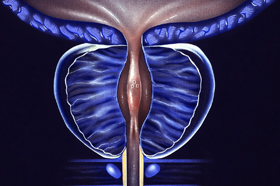Preclinical Evaluation of 225-Actinium Radioisotope Shows Suppressed Prostate Tumor Growth
 Blue Earth Therapeutics announced results from a series of preclinical analyses designed to evaluate the binding affinity, lipophilicity, cellular internalization and therapeutic efficacy of 225Ac-rhPSMA-10.1 in preclinical models for the treatment of prostate cancer, using 177Lu-rhPSMA-10.1 as a comparator. Results showed that both 225Ac-rhPSMA-10.1 and 177Lu-rhPSMA-10.1 demonstrated excellent PSMA binding affinity, high cellular internalization and similar lipophilicity.
Blue Earth Therapeutics announced results from a series of preclinical analyses designed to evaluate the binding affinity, lipophilicity, cellular internalization and therapeutic efficacy of 225Ac-rhPSMA-10.1 in preclinical models for the treatment of prostate cancer, using 177Lu-rhPSMA-10.1 as a comparator. Results showed that both 225Ac-rhPSMA-10.1 and 177Lu-rhPSMA-10.1 demonstrated excellent PSMA binding affinity, high cellular internalization and similar lipophilicity.
Therapeutic response and efficacy were evaluated in a preclinical prostate cancer model which showed that 225Ac-rhPSMA-10.1 significantly suppressed tumor growth relative to control. The data were presented in an oral presentation at the Annual Congress of the European Association of Nuclear Medicine (EANM’23) in Vienna, Austria. 225Ac-rhPSMA-10.1 is an investigational radiohybrid (rh) Prostate-Specific Membrane Antigen-targeted therapeutic radiopharmaceutical, and the lead alpha-emitting candidate in Blue Earth Therapeutics’ oncology development program of next generation therapeutic radiopharmaceuticals.
“We are pleased that the first presentation of preclinical results from Blue Earth Therapeutics’ prostate cancer program using rhPSMA-10.1 radiolabeled with 225Ac is being made to the nuclear medicine community at the EANM’23 Annual Meeting,” said David E Gauden,
DPhil, Chief Executive Officer of the Company. “Underscoring our commitment to advancing science, we are also honored that the abstract has been recognized as a “Top Rated Oral Presentation” by the Association. 225Ac-rhPSMA-10.1 is our second pipeline compound, and, like our lead Phase 1/2 compound 177Lu-rhPSMA-10.1, it is based on innovative radiohybrid PSMA theranostic technology. The radiohybrid platform enables molecules within the class to be modified and deployed for either diagnostic PET imaging or therapeutic applications, and they can also be developed with both beta- and alpha-emitting therapeutic radioisotopes. The pharmacokinetic profile of rhPSMA-10.1 was carefully optimized during development to deliver high radiation doses to prostate cancer lesions while sparing normal tissues as far as possible, and we are building on that work by radiolabeling it with the powerful alpha-emitting radioisotope, 225Ac.”
Dr Gauden continued, “Results from these preclinical analyses demonstrate a promising therapeutic profile for 225Ac-rhPSMA‑10.1, while using 1,000-fold lower radioactivity than 177Lu-rhPSMA-10.1, with similar in vitro characteristics and in vivo therapeutic efficacy observed for both compounds. 225Ac-rhPSMA-10.1 represents a novel alpha-targeted therapy that we intend to advance into the clinic. IND-enabling studies have been completed and we plan to initiate a Phase 1 clinical study of 225Ac-rhPSMA-10.1 in the first half of 2024.”
The findings presented at EANM’23 evaluated 225Ac-rhPSMA-10.1 and 177Lu-rhPSMA-10.1 in preclinical models for the treatment of prostate cancer. Binding affinity and cellular internalization assays were conducted in LNCaP cells, using 177Lu-PSMA-I&T as a reference compound. The lipophilicity of 225Ac-rhPSMA-10.1 and 177Lu-rhPSMA-10.1 was determined by the shake-flask method, measuring the distribution coefficient in n-octanol and PBS at pH 7.4 (log D7.4). Therapeutic response to single-administration of 225Ac-rhPSMA-10.1 (30 kBq) or 177Lu-rhPSMA-10.1 (30 MBq) was evaluated in the 22Rv1 preclinical model (n=8 per group). Efficacy was assessed based on relative tumor growth (change in tumor volume from treatment administration day/baseline) and survival of treated groups versus untreated controls ≤49 days post-treatment initiation. Body weights were monitored throughout for toxicity assessment.
Both natLa-rhPSMA-10.1 and natLu-rhPSMA-10.1 (natLa and natLu being cold surrogates of 225Ac and 177Lu) showed excellent PSMA binding affinity (IC50 = 3.6±0.6 nM and 1.6±0.1 nM, respectively). High cellular internalization and similar lipophilicity were observed for both 225Ac-rhPSMA‑10.1 and 177Lu-rhPSMA-10.1 (% internalization = 99±14 and 108±5; logD7.4 = -3.4±0.2 and -3.8±0.1; respectively). 225Ac-rhPSMA-10.1 treatment significantly reduced tumor growth in vivo versus controls (from day 14 to 31, p<0.05), and prolonged survival (median survival: 27, 43.5, and 42 days for untreated, 225Ac-rhPSMA-10.1, and 177Lu-rhPSMA-10.1 groups, respectively). There were no significant differences in tumor growth suppression or survival between the 225Ac‑rhPSMA-10.1 and 177Lu-rhPSMA-10.1 groups, and both treatments were well-tolerated.